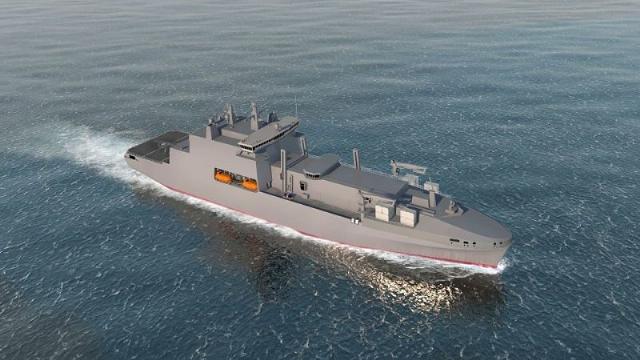The Spanish shipbuilding company Navantia will undertake a significant part of the construction of new logistics vessels of the FSS type for the Royal Navy of Great Britain. This is due to the fact that the Harland & Wolff shipyards, which are the contractor for this program and were recently acquired by Navantia, are not up to the task.
According to Navy Recognition, representatives of the Spanish company confirmed that most of the sections for the lead vessel will be built at the Cadiz plant, and not in the UK.

FSS Class Support Ship Design, United Kingdom
UK MoD
The FSS program was conceived as a key component of the development of the Royal Navy's auxiliary forces. These vessels are designed to deliver ammunition, food, spare parts, and other supplies to naval forces at sea, making them a vital element of aircraft carrier strike groups. The vessels will have a capacity of 100 crew members and up to 80 additional staff responsible for managing helicopters, speedboats or other tasks. In addition to resupply, FSS vessels will be able to support anti-piracy and counter-terrorism operations in cooperation with UK allies.
The vessels are being built on the basis of a project developed by the British company BMT. It was assumed that the main production would be deployed at the Harland & Wolff shipyards in Belfast (Northern Ireland) and Appledore (south-west of the United Kingdom).
The program for the construction of three supply vessels involves the creation of 1,200 jobs in British shipyards, and an additional 800 jobs are expected throughout the supply chain in the country. The total cost is estimated at 14 million man-hours. Production of the vessels is scheduled to start in 2025, and commissioning of all three vessels is scheduled before the end of 2032.
In January of this year, Navantia announced the completion of the acquisition of Harland & Wolff and its four shipyards (in addition to Belfast and Appledore, in Methil and Arnish).
Harland & Wolff was founded in 1861 in Belfast by Edward Harland, a Yorkshireman, and Gustav Wolf, a German. By the beginning of the 20th century, the company had become the largest builder of airliners in the world, employing more than 30,000 people. From 1909 to 1911, the shipyard was building the largest passenger liner at that time, the Titanic, which sank during its first voyage.
In addition, 140 warships and vessels, 123 merchant vessels, as well as more than 500 tanks were built at the shipyard during the Second World War. With the development of air travel in the late 1950s, demand for ocean liners collapsed, leading to a prolonged recession in the company's history. In 2003, the last ship, the ferry of the British Ministry of Defense Anvil Point, came off the stocks. Since then, the shipyard has mainly been engaged in the repair of ships, oil floating platforms, as well as wind turbines.
The contract for the supply of three FSS-type supply vessels for the British Navy was concluded in 2023. At that time, it was assumed that this deal would help the company gain financial stability.
